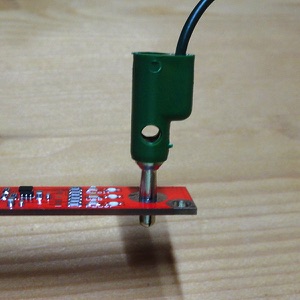Chipmunk eUSB Tester
The big idea with this tester is that you plug it into any motherboard (NAS, embedded system, etc) you are repairing. With one second of extra work it will give you all sorts of extra information about what is going on with the device, and sometimes it will save you big-time. For example you will aware of when the board is powered so you will not plug or unplug the internal LCD cable by accident with the power still on. Also differentiating between a machine that turns on but shows no image and a machine that does not turn on becomes trivial.
This is a simple but extremely useful tool for anyone repairing computers and laptops. Not only for Apple laptops, it works equally well on Dell etc. It has 3 lights showing power and USB activity, and it offers a versatile connection to the GND line of the computer.
When repairing any laptop it is important to know if the power rails are up.
The Chipmunk USB Tester has two red LEDs to show if the 5 volt on the USB port is present. The first LED (marked 'Power' on the USB tester or 'VBUS' on the USB-C tester) lights up if power is present on the 5 volt line. This LED is connected straight to the 5 volt line (well, via a resistor of course...) and will light up whenever any power above 2 volt is present on that line.
The second LED (marked '5volt') will only light up if the voltage is correct. Below 4.75 volts it will be off. Above 5.25 volts (5.4 in the case of the USB-C tester) it will blink. In the case of Macs with USB-C this blinking is important as quite often these Mcas fail and will output 20 volts on the USB-C port, frying anything that you plug in!
The middle LED (marked 'USB') is green and lights up whenever there is activity on the USB bus. As the USB bus on an Apple or Intel laptop is driven by the PCH, this will indicate that the PCH and hence the CPU are running. On a computer with an image on the screen you would know that already, but in the case of a laptop with no image on the screen that is valuable information.
When working on a loose motherboard this tool becomes extremely useful and enables you to see at a glance in how far the board is working. Like the Louis Rossmann 'Fan spin' but better. If the green 'USB' LED gives a few blinks then you know that the CPU/PCH is working.
The Chipmunk USB Tester also gives you an easy access to the computer's GND line. The hole near the corner is meant for attaching an alligator clip or grabber like the ground clip of an oscilloscope probe but you could even solder onto it. The middle hole is 4mm is size and allows you to mount the binding-post allowing you to connect loose wires or insert a 4mm banana plug. If the binding post is not in place then you can plug a banana plug straight into the hole. Both holes have a high-current connection to the computer (up to 2 amps). So when injecting power straight into a power rail you can use this as the ground connection, saving you the soldering of a ground wire. When doing diode-mode reading simply plug the red lead into the Chipmunk USB Tester and you will have freed up one hand to write down your measurements.



Even without the Binding-Post you can connect a 4mm banana plug.
Connect a crocodile clip. In this case the ground connection when measuring with an oscilloscope.
Connect a grabber, for example to the ground of the multimeter when measuring voltages on a board.
For ease of use the set of 3 LEDs is mounted on both sides of the board. No matter which way round the motherboard is on your desk you can always see the LEDs.
The Power LED (red) lights up whenever there is power supplied to the USB port. Any power from about 2 volts will light up the LED. This will show you at a glance if the computer is powered.
The 5volt LED (red) will only light up if the voltage is actually 5 volt, or at least within five percent. This will show you that at least the 5 volt rail is working fine.
The USB LED (green) will blink if there is any activity on the USB bus. Depending on the computer you are working on this might mean different things, but in general if this LED blinks it means that the CPU/PCH is running.
Chipmunk eUSB Tester (2.0 mm pitch, DOM, 9-pin small )
A4621: 59 euro
All prices include shipping world wide.
A4621 Chipmunk eUSB Tester
Technically identical to the A4551 but with a 2.0 mm pitch eUSB/DOM connector.
PCB (red 6cm x 1.6cm).

Chipmunk eUSB Tester (2.54 mm pitch, DOM, 9-pin big )
A4632: 59 euro
All prices include shipping world wide.
A4632 Chipmunk eUSB Tester
Technically identical to the A4551 but with a 2.54 mm pitch eUSB/DOM connector.
PCB (red 6cm x 1.6cm).
Chipmunk USB-A to eUSB Adapter (2.0 & 2.54 mm)
This adapter allows you to connect (and hence read and write) eUSB DOM (Disk On Module) boards using a normal computer with a normal USB-A port.
A4620: 59 euro
All prices include shipping world wide.




The Chipmunk eUSB Adapter.
There are also three LEDs visible on the back.
A 2.54 mm pitch DOM module plugs into the large connector.
A 2.0 mm pitch DOM module plugs into the small connector.
